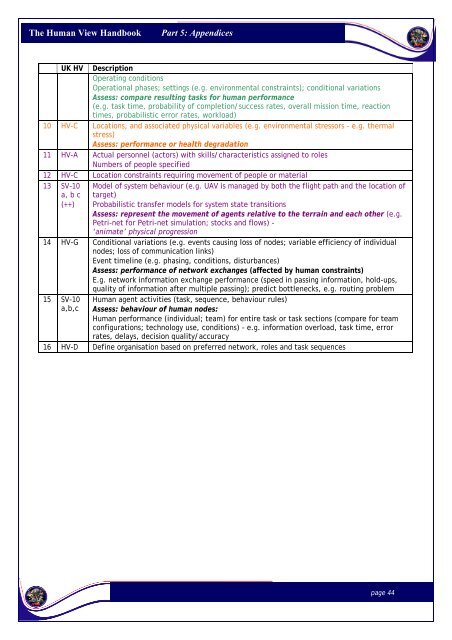The Human View Handbook for MODAF: Part V â Appendices
The Human View Handbook for MODAF: Part V â Appendices
The Human View Handbook for MODAF: Part V â Appendices
Create successful ePaper yourself
Turn your PDF publications into a flip-book with our unique Google optimized e-Paper software.
<strong>The</strong> <strong>Human</strong> <strong>View</strong> <strong>Handbook</strong><br />
<strong>Part</strong> 5: <strong>Appendices</strong><br />
UK HV Description<br />
Operating conditions<br />
Operational phases; settings (e.g. environmental constraints); conditional variations<br />
Assess: compare resulting tasks <strong>for</strong> human per<strong>for</strong>mance<br />
(e.g. task time, probability of completion/success rates, overall mission time, reaction<br />
times, probabilistic error rates, workload)<br />
10 HV-C Locations, and associated physical variables (e.g. environmental stressors – e.g. thermal<br />
stress)<br />
Assess: per<strong>for</strong>mance or health degradation<br />
11 HV-A Actual personnel (actors) with skills/characteristics assigned to roles<br />
Numbers of people specified<br />
12 HV-C Location constraints requiring movement of people or material<br />
13 SV-10<br />
a, b c<br />
(++)<br />
Model of system behaviour (e.g. UAV is managed by both the flight path and the location of<br />
target)<br />
Probabilistic transfer models <strong>for</strong> system state transitions<br />
Assess: represent the movement of agents relative to the terrain and each other (e.g.<br />
Petri-net <strong>for</strong> Petri-net simulation; stocks and flows) -<br />
‘animate’ physical progression<br />
14 HV-G Conditional variations (e.g. events causing loss of nodes; variable efficiency of individual<br />
nodes; loss of communication links)<br />
Event timeline (e.g. phasing, conditions, disturbances)<br />
Assess: per<strong>for</strong>mance of network exchanges (affected by human constraints)<br />
E.g. network in<strong>for</strong>mation exchange per<strong>for</strong>mance (speed in passing in<strong>for</strong>mation, hold-ups,<br />
quality of in<strong>for</strong>mation after multiple passing); predict bottlenecks, e.g. routing problem<br />
15 SV-10<br />
a,b,c<br />
<strong>Human</strong> agent activities (task, sequence, behaviour rules)<br />
Assess: behaviour of human nodes:<br />
<strong>Human</strong> per<strong>for</strong>mance (individual; team) <strong>for</strong> entire task or task sections (compare <strong>for</strong> team<br />
configurations; technology use, conditions) – e.g. in<strong>for</strong>mation overload, task time, error<br />
rates, delays, decision quality/accuracy<br />
16 HV-D Define organisation based on preferred network, roles and task sequences<br />
page 44
















